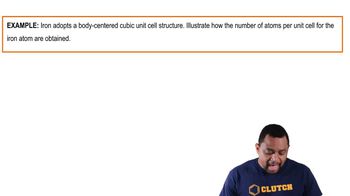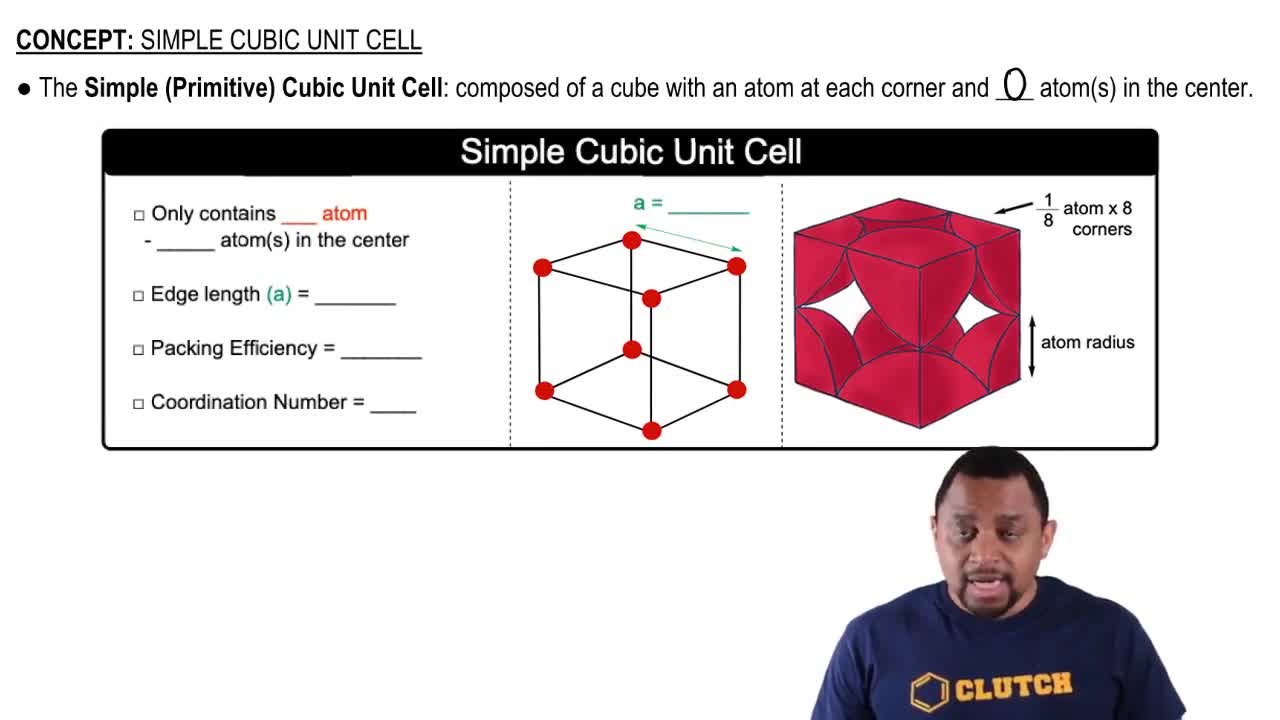Consider the unit cells shown here for three different structures that are commonly observed for metallic elements. (b) Which structure(s) corresponds to the least dense packing of atoms?
Ch.12 - Solids and Modern Materials
Chapter 12, Problem 36a
Calcium crystallizes in a body-centered cubic structure at 467°C. (a) How many Ca atoms are contained in each unit cell?
 Verified step by step guidance
Verified step by step guidance1
Understand the structure: A body-centered cubic (BCC) structure has atoms at each corner of the cube and one atom in the center of the cube.
Calculate the contribution of corner atoms: Each corner atom is shared by 8 adjacent unit cells, so each corner atom contributes \( \frac{1}{8} \) of an atom to the unit cell.
Calculate the total contribution from corner atoms: Since there are 8 corners in a cube, the total contribution from corner atoms is \( 8 \times \frac{1}{8} = 1 \) atom.
Consider the center atom: In a BCC structure, there is one whole atom located at the center of the cube, contributing fully to the unit cell.
Add the contributions: The total number of Ca atoms in a BCC unit cell is the sum of the corner atoms and the center atom, which is \( 1 + 1 = 2 \) atoms.

Verified video answer for a similar problem:
This video solution was recommended by our tutors as helpful for the problem above.
Video duration:
1mWas this helpful?
Key Concepts
Here are the essential concepts you must grasp in order to answer the question correctly.
Body-Centered Cubic (BCC) Structure
The body-centered cubic (BCC) structure is a type of crystal lattice where atoms are located at each of the eight corners of a cube and a single atom is positioned at the center of the cube. This arrangement results in a coordination number of 8, meaning each atom is in contact with eight neighboring atoms. Understanding this structure is essential for determining the number of atoms per unit cell.
Recommended video:
Guided course

Body Centered Cubic Example
Unit Cell
A unit cell is the smallest repeating unit in a crystal lattice that reflects the symmetry and structure of the entire crystal. It defines the arrangement of atoms in the crystal and is characterized by its dimensions and angles. In the case of BCC, the unit cell contains a specific number of atoms that can be calculated based on the arrangement of atoms within the cell.
Recommended video:
Guided course

Simple Cubic Unit Cell
Atomic Packing Factor (APF)
The atomic packing factor (APF) is a measure of how efficiently atoms are packed in a unit cell. It is calculated as the ratio of the volume occupied by the atoms in the unit cell to the total volume of the unit cell. For BCC structures, the APF is approximately 0.68, indicating that 68% of the volume is filled with atoms, which helps in understanding the density and stability of the crystal structure.
Recommended video:
Guided course

Conversion Factors
Related Practice
Textbook Question
Textbook Question
Sodium metal (atomic weight 22.99 g/mol) adopts a body-centered cubic structure with a density of 0.97 g/cm3. (a) Use this information and Avogadro’s number (NA = 6.022 × 1023/mol) to estimate the atomic radius of sodium. (b) If sodium didn't react so vigorously, it could float on water. Use the answer from part (a) to estimate the density of Na if its structure were that of a cubic close-packed metal. Would it still float on water?
Textbook Question
Calcium crystallizes in a face-centered cubic unit cell at room temperature that has an edge length of 5.588 Å.
a. Calculate the atomic radius of a calcium atom.
b. Calculate the density of Ca metal at this temperature.
